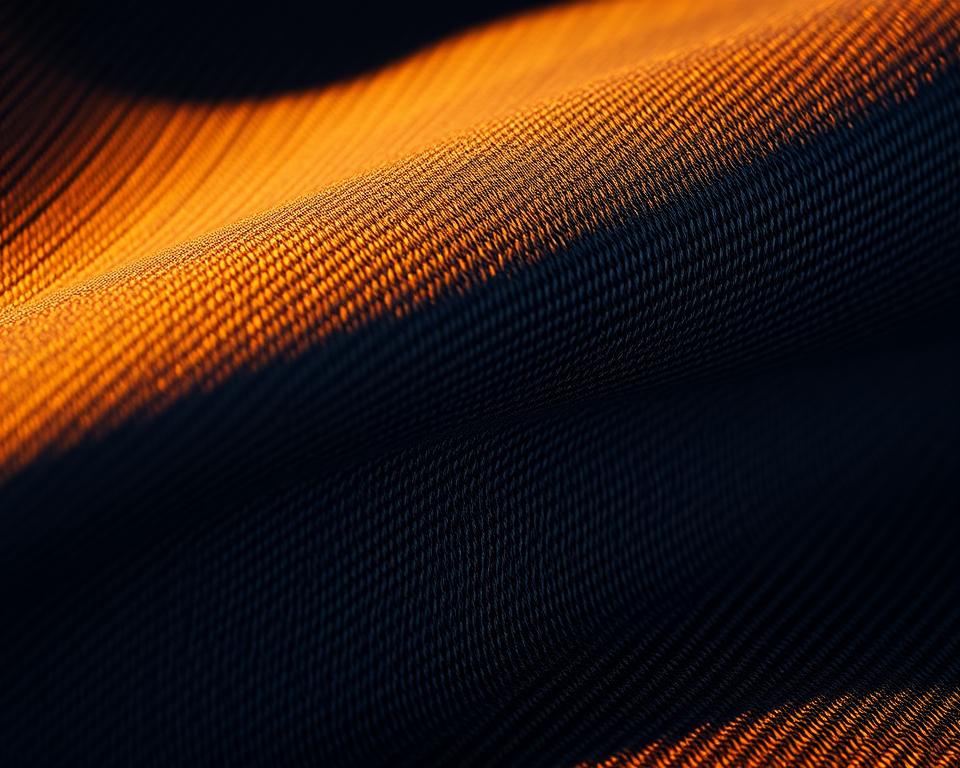A Comprehensive Guide for Premium denim Edge-to-Edge Fabric
Have you ever pondered the reason certain trousers seem as though they are designed for longevity the ages? Everything revolves around the components and skill. Consider the rising movement of high-end selvedge. This isn’t just any fabric—it attests to superiority and legacy.
Nowadays, increasingly more individuals are opting for these everlasting textiles for their sturdiness and iconic selvedge denim by the yard charm. Whether you’re a home sewing sewist or a denim enthusiast, there’s a unique quality about using superior natural fiber and thread. It’s not just about making pants; it involves fashioning something that tells a story.
Here at Core Fabrics, we’ve selected a range of 14.25oz organic cotton and elastic options. Such textiles are ideal for everything from raw jeans to high-fashion jacket blueprints. Ready to explore the world of premium fabrics? Let us delve in.
What Is Denim Selvedge Fabric?
What is it that makes certain trousers stand out with their distinctive, finished without extra steps seams? The secret resides in the selvedge denim, a high-quality material known for its durability and old-school aesthetic. Unlike standard textiles, this fabric is fashioned using time-honored methods that have proven their worth.
The Definition of Selvedge Denim
Selvedge denim is produced via retro shuttle looms, which yield minimal widths of about 30-35 inches. They intertwine the textile in a method that delivers self-finished edges, often accented with a characteristic red line. Such a process guarantees the material is tightly woven and exceptionally sturdy.
Modern looms, in contrast, generate wider material but do not offer the same level of artistry. Subtle irregularities in selvedge, like twists in the leg or uneven textures, are accepted as features of its character. This ideology, known as “the beauty of imperfection”, exalts the aesthetic of inherent flaws.
How Selvedge Denim Is Made
The creation of selvedge denim entails a detailed process. Traditional shuttle looms interlace the horizontal threads back and forth, resulting in a compact and resilient material. This process stands in contrast with contemporary machines, which focus on speed and efficiency over quality.
Companies such as Karson Denim preserve time-honored Japanese craft practices from the 1990s. They deliberately incorporate anomalies to preserve the genuineness of the fabric. All products is graded on a four-point system, guaranteeing it fulfills the highest standards of excellence.
| Characteristic | Selvedge Denim | Current Denim |
|---|---|---|
| Width | 30-35 inches | 60+ inches |
| Construction Technique | Classic Shuttle Loom | Modern Loom |
| Texture | Irregular, Flawed | Even |
| Strength | Superior | Moderate |
“The charm of selvedge lies in its imperfections—each flaw tells a story skill and legacy.”
The Legacy of Selvedge Denim
From humble beginnings to global acclaim, the narrative of these materials is multifaceted and moving. What started as rugged attire in 17th-century France has become a signifier of classic elegance and excellence.
Historical Roots
The origin of this fabric dates back to Nîmes, France, where it was dubbed “serge de Nîmes.” Initially created for laborers, it was constructed with sturdy cotton and thread. Its resilience ensured its popularity among laborers during the era of the Gold Rush.
During the twentieth century, it had transformed into a staple for pants. The shuttering of the Cone Mills White Oak facility served as a catalyst. This shift opened the door for Japanese artisans to reintroduce old-world weaving methods.

Evolution in Modern Denim Production
Following WWII, Japan embraced vintage American culture. Skilled workers restored old looms to create authentic reproductions. This devotion to quality guaranteed the continuance of selvedge as a niche product.
Currently, breakthroughs from Italy and Turkey have launched environmentally conscious mixtures and elastic options. These advancements have enhanced the attraction of this timeless textile. Here at Core Fabrics, we procure internationally, from Montréal to Asia, to offer you the best standards.
“Selvedge’s story is a tribute to the lasting worth of quality and tradition.”
Why Choose Selvedge Denim?
Why does selvedge denim distinguish itself in the world of top-tier textiles? Its special characteristics and exceptional longevity render it popular among aficionados and stylists alike. Whether you’re crafting trousers or a sharp jacket, this textile provides a blend of heritage and modern appeal.
Distinctive Attributes of Selvedge
Selvedge denim is known for its dense construction, which boosts ripping resistance and color fading characteristics. Differing from regular textiles, denim selvedge fabric is produced using classic shuttle looms, creating a denser and extra robust product. This process ensures that every item possesses a singular finish and personality.
Key features include:
- Hairy, rigid raw denim contrasts with pre-washed comfort stretches.
- Sanforization stabilizes the fabric for consistent measurements, while raw options offer a unique shrinkage journey.
- Variants include 9.5oz Eco Finish to 14.25oz Organic, meeting diverse applications.
Durability and Longevity
One of the most remarkable aspects of selvedge denim is its enduring nature. The tighter weave both reinforces strength and permits characteristic wear patterns over time. This makes it a wise purchase for those in pursuit of classic garments.
Important aspects:
- Mid-weight fabrics from 12oz to 14oz work well for tailored jackets and evolving jeans.
- The 14.25oz True Indigo option is highly favored for enduring jeans.
- Sustainable variants such as recycled cotton combined with indigo blends enhance eco-friendliness.
At Core Fabrics, our collection includes a variety of options to suit your needs. Spanning from raw finishes to sanforized treatments, each selection is designed for superior quality and value.
Selvedge vs. Wide Denim: A Comparison
In the creation of robust and fashionable apparel, the decision of material matters significantly. Among the prevalent selections are selvedge and wide denim, each possessing distinct traits. Comprehending their variances guides the best option for your endeavor.
Contrasting Weave Techniques
Selvedge denim is crafted with classic shuttle looms, yielding limited spans of 30-35 inches. This striped selvedge denim fabric process creates firm borders, often marked by a distinctive red line. In contrast, wide denim is produced using modern projectile looms, resulting in expansive widths of over 60 inches.
Traditional shuttle looms operate at approximately 3 meters per minute, while contemporary projectile looms achieve up to 30m per minute. Such speed differences influence both the expense and the finish of the outcome.
Benefits and Drawbacks
Selvedge denim is celebrated for its superior quality and strength. Its narrow width makes it ideal for applications where visible hems or patches are desired. However, it can be costlier, generally priced at $23 per meter.
Wide denim is economical, priced around $8 per half-meter. Its wider width minimizes excess, making it suitable for large projects like upholstery. However, it lacks the unique edge finish of selvedge.
| Characteristic | Selvedge Denim | Wide Denim |
|---|---|---|
| Span | 30-35 inches | 60+ inches |
| Technique | Shuttle Loom | Modern Projectile |
| Production Speed | 3m/min | 30m per minute |
| Expense | $23/meter | $8 per half-meter |
For structured edges, like those needed in Grainline Thayer jackets, selvedge is the preferred choice. For larger projects, wide denim offers better value and efficiency. Evaluate your project specifications to choose wisely.
How to Use Selvedge Denim
Working with premium materials can elevate your sewing projects to the next level. Whether you’re crafting pants, jackets, or frocks, grasping fabric quantities, proper sewing methods, and maintenance guarantees a polished result. Let’s explore how to make the most of this everlasting textile.
Yardage Needed for Jeans and Jackets
Determining the proper yardage is key to a successful project. Men’s jeans typically require roughly 3-3.3 yards, factoring in flaws and potential shrinkage. Trucker jackets typically require 3.3 yards, while skirts can be made with just 2 yards.
Innovative layout techniques can mitigate fabric flaws. Rather than avoiding imperfections, incorporate them into your pattern for distinctive style.
| Garment | Fabric Needed |
|---|---|
| Jeans for Men | 3–3.3 yards |
| Trucker Jacket | 3.3 yards |
| Skirt Item | 2 yards |
Sewing Techniques and Maintenance
Using the right tools and techniques ensures a polished result. Opt for #70 to 110 needles and presser foot attachments suitable for thick fabrics. Gütermann rPET thread works well for contrasting stitches.
Here are some additional tips:
- Employ a tailor’s clapper to achieve crisp creases without gloss.
- Core Fabrics’ denim kits include topstitch thread, rivets, and 9mm jeans buttons for a professional finish.
- Structured edges, essential for jackets, are best achieved with selvedge.
Correct care ensures your garments last longer. Limit washing and allow to air dry for optimal durability. Following these guidelines guarantees enduring results.
Wrapping It Up
Working with high-end textiles is not solely about longevity; it’s about infusing character. Selvedge denim embodies this principle, blending craftsman allure with robust strength. Be it crafting jeans or tailoring a refined jacket, each stitch narrates a tale.
With Core Fabrics, unleashing your creative potential is effortless. Our swatch service lets you touch and test the fabric before deciding. Additionally, benefit from complimentary shipping on orders exceeding $150 USD throughout North America.
Future trends in cotton textiles include sustainable blends and retro washes. These trends offer new ways to add sustainability and style to your wardrobe.
Prepared to immerse yourself in superior fabrics? Begin your journey now and appreciate the merit of intentional crafting. Your future project might just be that lasting masterpiece.

